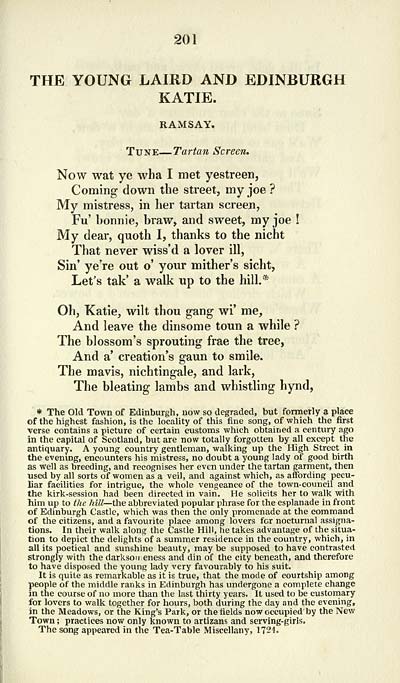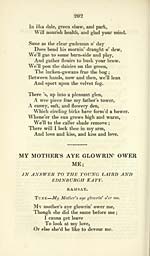Glen Collection of printed music > Printed text > Scottish songs > Volume 1
(303) Page 201 - Young Laird and Edinburgh Katie
Download files
Complete book:
Individual page:
Thumbnail gallery: Grid view | List view

201
THE YOUNG LAIRD AND EDINBURGH
KATIE.
RAMSAY.
Tune — Tartan Screen.
Now wat ye wha I met yestreen,
Coming down the street, my joe ?
My mistress, in her tartan screen,
Fu' bonnie, braw, and sweet, my joe I
My dear, quoth I, thanks to the nicht
That never wiss'd a lover ill.
Sin' ye 're out o' your mither's sicht,
Let's tak' a walk up to the hill.*
Oh, Katie, wilt thou gang wi' me.
And leave the dinsome toun a while ?
The blossom's sprouting frae the tree,
And a' creation's gaun to smile.
The mavis, nichtingale, and lark.
The bleating lambs and whistling hynd,
* The Old Town of Edinburgh, now so degraded, but formerly a place
of the highest fashion, is the locality of this fine song, of which the first
verse contains a picture of certain customs which obtained a century ago
in the capital of Scotland, but are now totally forgotten by all except the
antiquary. A young country gentleman, walking up the High Street in
the evening, encounters his mistress, no doubt a young lady of good birth
as well as breeding, and recognises her even under the tartan garment, then
used by all sorts of women as a veil, and against which, as affording pecu-
liar facilities for intrigue, the whole vengeance of the town-council and
the kirk-session had been directed in vain. He solicits her to walk with
him up to the hill— the abbreviated popular phrase for the esplanade in front
of Edinburgh Castle, which was then the only promenade at the command
of the citizens, and a favourite place among lovers for nocturnal assigna-
tions. In their walk along the Castle Hill, he takes advantage of the situa-
tion to depict the delights" of a summer residence in the country, which, in
all its poetical and sunshine beauty, may be supposed to have contrasted
strongly with the darkson eness and din of the city beneath, and therefore
to have disposed the young lady very favourably to his suit.
It is quite as remarkable as it is true, that the mode of courtship among
people of the middle ranks in Edinburgh has undergone a complete change
in the course of no more than the last thirty years. It used to be customary
for lovers to walk together for hours, both during the day and the evening,
in the Meadows, or the King's Park, or the fields now occupied by the New
Town ; practices now only known to artizans and serving-girls.
The song appeared in the Tea-Table Miscellany, 1724.
THE YOUNG LAIRD AND EDINBURGH
KATIE.
RAMSAY.
Tune — Tartan Screen.
Now wat ye wha I met yestreen,
Coming down the street, my joe ?
My mistress, in her tartan screen,
Fu' bonnie, braw, and sweet, my joe I
My dear, quoth I, thanks to the nicht
That never wiss'd a lover ill.
Sin' ye 're out o' your mither's sicht,
Let's tak' a walk up to the hill.*
Oh, Katie, wilt thou gang wi' me.
And leave the dinsome toun a while ?
The blossom's sprouting frae the tree,
And a' creation's gaun to smile.
The mavis, nichtingale, and lark.
The bleating lambs and whistling hynd,
* The Old Town of Edinburgh, now so degraded, but formerly a place
of the highest fashion, is the locality of this fine song, of which the first
verse contains a picture of certain customs which obtained a century ago
in the capital of Scotland, but are now totally forgotten by all except the
antiquary. A young country gentleman, walking up the High Street in
the evening, encounters his mistress, no doubt a young lady of good birth
as well as breeding, and recognises her even under the tartan garment, then
used by all sorts of women as a veil, and against which, as affording pecu-
liar facilities for intrigue, the whole vengeance of the town-council and
the kirk-session had been directed in vain. He solicits her to walk with
him up to the hill— the abbreviated popular phrase for the esplanade in front
of Edinburgh Castle, which was then the only promenade at the command
of the citizens, and a favourite place among lovers for nocturnal assigna-
tions. In their walk along the Castle Hill, he takes advantage of the situa-
tion to depict the delights" of a summer residence in the country, which, in
all its poetical and sunshine beauty, may be supposed to have contrasted
strongly with the darkson eness and din of the city beneath, and therefore
to have disposed the young lady very favourably to his suit.
It is quite as remarkable as it is true, that the mode of courtship among
people of the middle ranks in Edinburgh has undergone a complete change
in the course of no more than the last thirty years. It used to be customary
for lovers to walk together for hours, both during the day and the evening,
in the Meadows, or the King's Park, or the fields now occupied by the New
Town ; practices now only known to artizans and serving-girls.
The song appeared in the Tea-Table Miscellany, 1724.
Set display mode to: Large image | Transcription
Images and transcriptions on this page, including medium image downloads, may be used under the Creative Commons Attribution 4.0 International Licence unless otherwise stated. ![]()
| Special collections of printed music > Glen Collection of printed music > Printed text > Scottish songs > Volume 1 > (303) Page 201 - Young Laird and Edinburgh Katie |
|---|
| Permanent URL | https://digital.nls.uk/90292528 |
|---|
| Shelfmark | Glen.105 |
|---|---|
| Additional NLS resources: | |
| Attribution and copyright: |
|
| Description | Scottish songs and music of the 18th and early 19th centuries, including music for the Highland bagpipe. These are selected items from the collection of John Glen (1833 to 1904). Also includes a few manuscripts, some treatises, and other books on the subject. |
|---|
| Description | The Glen Collection and the Inglis Collection represent mainly 18th and 19th century Scottish music, including Scottish songs. The collections of Berlioz and Verdi collected by bibliographer Cecil Hopkinson contain contemporary and later editions of the works of the two composers Berlioz and Verdi. |
|---|

